
views
- The Isha prayer has 4 mandatory rakat called Fard and 13 optional rakat called Sunnah, Nafl, and Witr.
- Perform the Fard rakat by proclaiming “Allahu Akbar” (“God is the greatest.”) and moving your body between standing, kneeling, and prostrating.
- The Sunnah, Nafl, and Witr prayers are all optional, but each has special benefits that can bring you closer to Allah.
How many rakat are in Isha?

There are 4 mandatory and 13 optional rakat in the Isha prayer. Isha is one of the five daily prayers (salat) Muslims perform. Each prayer consists of certain repetitive cycles of prayers, bows, and prostrations known as rakat. The Isha prayer is performed after twilight but before midnight, and it consists of 4 mandatory rakat known as Fard and 13 optional rakat called Sunnah, Nafl, and Witr. The rakat are performed in the following order: Sunnah Ghair mu’akkadah: 4 rakat Sunnah Ghair mu’akkadah are “non-confirmed” Sunnah that the Prophet Muhammad only sometimes performed. Fard: 4 rakat Sunnah mu’akkadah: 2 rakat Sunnah mu’akkadah are “confirmed” Sunnah prayers which the Prophet Muhammad always performed and never omitted. They’re still optional but more recommended than the Sunnah Ghair mu’akkadah Nafl: 2 rakat Nafl are completely optional prayers that are said to draw a person closer to Allah. Witr: 3 rakat While many Muslims view Witr as a voluntary prayer, some believe that it’s obligatory to perform alongside Fard. You have the option to perform 1, 3, 5, 7, or 9 rakat of Witr. Nafl: 2 rakat The rakat for each type of prayer are performed with the same recitations and body movements. Some may have additional recitations depending on the prayer.
Performing the First Rak’ah

Wash yourself with clean water. Prepare yourself to pray by first performing wudu, which is a ritual cleansing. Start by washing your hands and arms, then wash your face and inhale a small amount of the water through your nose. Lastly, wash your feet. In terms of clothing, men are required to cover the front and back of their bodies from the navel to the knees. They must also cover their shoulders. The garments they wear must be loose and not transparent. Women must cover their entire bodies except for their hands and faces. Their clothing must also be loose but not transparent in any way.

Stand facing Mecca and say “Allahu Akbar.” Clear your mind and focus on your intention to pray. This intention is known as niyyat. Once you’re ready, raise your hands to either side of your head and say “Allahu Akbar” (“God is the greatest.”). Then, place your right hand on your chest and recite “A’oothu billaahi minash-shaytanir-rajeem” (“I seek refuge with Allah from Satan the accursed.”). This opening sequence is called the Takbir.
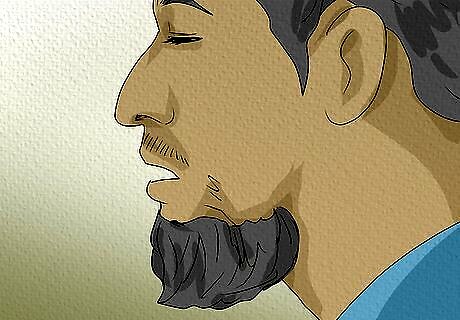
Recite the first chapter of the Qur’an followed by another chapter. Remain standing and keep your right hand on your chest. In this position, recite the Surat al-Fatiha; the very first chapter of the Qur’an. When you’re finished, choose any other passage from the Qur’an that you’d like to read, such as the Surat al-Ikhlas. The two passages are as follows: Surat al-Fatiha: Bismillaahi’r-Rahmaani’r-Raheem Al-hamdu lillaahi rabbil-`aalameen Arrahmaanir raheem Maaliki yawmid-deen Iyyaaka na`budu wa iyyaaka nasta`een Ihdinas-siraat al-mustaqeem siraat al-ladheena an`amta `alayhim ghayril maghdoobi `alayhi wa la’d-daalleen In the Name of God, the Merciful, the Compassionate Praise belongs to God, Lord of the World, the Merciful, the Compassionate, Master of the Day of Judgement; We worship only You, and from You alone do we seek help. Lead us on the straight path, the path of those whom You have blessed, not of those on whom is [Your] Wrath, nor of those who have gone astray. Surat al-Ikhlas: Bismillaahi’r-Rahmaani’r-Raheem Qul huwallaahu ahad / Allaahus samad Lam yalid walam yoolad Wa lam yakullahu kufuwan ahad In the Name of God, the Merciful, the Compassionate Say: ‘He is God, the One, God the Eternal and Besought of all, Neither begetting nor begot, Nor is there anything comparable or equal to Him.

Say “Allahu Akbar” and bow at the waist. Bring your hands to your earlobes and recite “Allahu Akbar” once more. Then, bend at the waist until you can place your hands on your knees. Once you’re in this position, say “Subhaana rabbiy al-`azeemi wa bihamdih” (“Glory be to my Lord, the Great, and praise belongs to Him.”). Next, stand up straight again and say “Sami`allaahu liman hamidah” (“God hears the one who praises Him”).

Say ”Allahu Akbar” and get on your hands and knees. As you recite the Takbir once more, lower yourself into a prostrating position so that your forehead, nose, knees, palms, and big toes are touching the ground. This position is called the sujud. In this position, say, “Subhaana rabbiy al-a`laa wa bihamdih” (“Glory be to my Exalted Lord, and praise belongs to Him.”).

Sit back on your heels and say “Allahu Akbar,” then “Rabbighfirlee”. Sit upright and place your weight on your left thigh. Rest your left foot flat along the ground, keep your right foot upright with just your toes touching the ground, and place your hands on your knees. In this position, recite the “Allahu Akbar” once again and then say “Rabbighfirlee” (“Oh Allah, forgive me.”).

Return to the sujud position and say “Allahu Akbar.” For the final part of the first rak’ah, return to the prostrating position on your hands and knees and say “Allahu Akbar” as you lower your body. Once in this position, say, “Subhaana Rabbiy-al-Aalaa” (“Glory be to my Lord, the Highest”) 3 times. You’ve now completed the first rak’ah of Isha.
Performing the Second Rak’ah
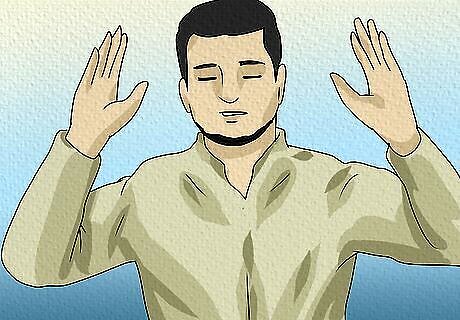
Stand up and repeat the first rak’ah once more. Stand up from your prostrating position, raise your hands up near your earlobes, and say “Allahu Akbar” to start the first rak’ah once again. Then, proceed to say the Surat al-Fatiha and complete the first rak’ah all the way through the final sujud position.
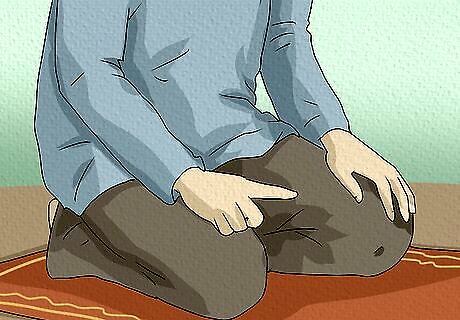
Sit back on your heels with your right index finger raised. Say “Allahu Akbar” once more, then assume the kneeling position once more placing your weight on your left thigh. Press the front of your left foot flat to the ground and only have the toes of your right foot on the ground. Then, place your hands on your knees and raise your right index finger so that it’s pointing toward Mecca. In this position, recite the Tashahud to finish the rak’ah. Tashahud: Ash hadu al laa ilaaha illallaahu wahdahu laa shareeka lah, wa ash hadu anna Muhammadan `abduhu wa rasuluh Allaahumma salli `alaa Muhammadin wa Aali Muhammad I bear witness that there is no god apart from Allah, Who is unique and without partners. I also bear witness that Muhammad is His servant and His Prophet. O God, bless Muhammad and the progeny of Muhammad.
Performing the Third & Fourth Rak’ah

Repeat the first rak’ah. Stand back up, recite “Allahu Akbar” with your hands near your earlobes, and repeat the first rak’ah once more to complete the third rak’ah. However, instead of reciting the Surat al-Fatiha, you have the option of saying the al-Tasbihat al-Arba’ah 3 times. After this, continue performing the first rak’ah until the very last sujud position. The al-Tasbihat al-Arba’ah is as follows: Subhaanallaahi wa’l hamdu lillaahi wa laa ilaaha illallaahu wallaahu akbar Glory be to God, and praise be to God; there is no god but Allah, and Allah is Greater.
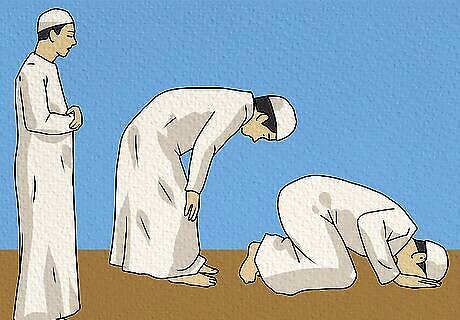
Perform the second rak’ah once more. The fourth rak’ah is simply a repetition of the second rak’ah. Go through the motions of the second rak’ah once more all the way through reciting the Tashahud. You’ve now completed the 4 Fard of the Isha prayer and are now ready to move on to completing the prayer.
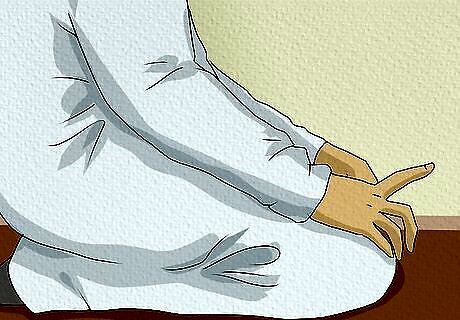
Sit in the kneeling position with your right index finger raised. Maintain the kneeling position that you ended up in at the end of the fourth rak’ah, placing your weight on your left thigh and raising your right index finger to point toward Mecca. Then, recite the following prayer: Allahumma salli alaa Muhammadiw wa alaa aali Muhammadin, kamaa sallayta alaa Ibraheema wa alaa aali Ibraheema, innaKa Hameedum Majeed. Allahumma baarik ‘alaa Muhammadiw wa alaa aali Muhammadin, kamaa baarakta alaa Ibraheema wa alaa aali Ibraheema, innaKa Hameedum Majeed O Allah, send Your mercy upon Muhammad and the family of Muhammad, just as You sent mercy upon Ibrahim and the family of Ibrahim. Truly You are Praiseworthy and Glorious. O Allah, send blessings upon Muhammad and the family of Muhammad, just as You sent blessings upon Ibrahim and the family of Ibrahim. Truly You are Praiseworthy and Glorious.

Finish by reciting the Taslim. Remain in the kneeling position, turn your head to the right, and say, “Assalaamu ‘alaykum wa rahmatullah” (“May Allah’s peace and mercy be upon you”). Then, turn your head to the left and repeat the verse to officially finish the fourth rak’ah.
Optional Rakat

There are various Sunnah and Nafl prayers to choose from. These prayers are completely optional, and you’re free to choose which prayers you’ll perform before and after you’ve completed the compulsory Fard rakat. Some examples of Sunnah and Nafl prayers include: Salat ul Taubah (Prayer of Repentance): This prayer usually has 2 rakat, and you should only perform it when you are looking for forgiveness for you sins. Salaat ul Istikhaarah (Prayer of Seeking Counsel): You perform this prayer when you’re seeking Allah’s guidance about a decision in your life. This prayer usually has 2 rakat. Tahajjud (Night Prayer): This Nafl can only be performed after Isha, and people pray it to gain mental strength and peace. It can have 2 to 12 rakat depending on how many you choose to perform. Some believe that Sunnah and Nafl prayers are the same, while others argue that Sunnah prayers are specifically those that the Prophet Muhammad did persistently.

Many people usually perform 3 rakat of Witr. The rakat Muslims perform during the Witr prayer are the same as those in the Fard prayer. Since there’s an odd number of rakat, you have the option of performing all 3 one after another with 1 recitation of the Tashahud, or performing 2 rakat together, reciting the Taslim, then performing the last rak’ah on its own. After reciting the Surat al-Fatiha, many recommend reciting the Surat al-A’la for during the first rak’ah, Surat al Kaafiroon for the second, and Surat al-Ikhlaas for the third. The last rak’ah often includes a supplication called Qunoot, which is an additional recitation you say before ruku (kneeling), or after ruku while standing. The supplication is: Allaahumma ihdinee feeman hadayta wa `aafinee feeman `aafayta wa tawallanee feeman tawallayta, wa baarik lee feemaa a`tayta, waqinee sharra maa qadayta, fa’innaka taqdee wa laa yuqdaa `alayka, innahu laa yadhillu man walayta, wa laa ya`izu man `adayta, tabaarakta rabbanaa wa ta`aalayta O Allah, guide me along with those whom You have guided, pardon me along with those whom You have pardoned, be an ally to me along with those whom You are an ally to and bless for me that which You have bestowed. Protect me from the evil You have decreed, for verily You decree and none can decree over You. For surety, he whom You show allegiance to is never abased and he whom You take as an enemy is never honored and mighty. O our Lord, Blessed and Exalted are You.
How many rakat are in the other daily prayers?

Each daily prayer requires a different amount of rakat. Fajr (dawn prayer) has 2 Fard rakat, Dhuhr (noon prayer) and Asr (later afternoon prayer) have 4, and Maghrib (sunset prayer) has 3. Each daily prayer also has a different number of Sunnah and/or Nafl rakat you can choose to perform. Fajr: 2 rakat of Sunnah, 2 rakat of Fard Dhuhr: 4 rakat of Sunnah, 4 rakat of Fard, 2 rakat of Sunnah, 2 rakat of Nafl Asr: 4 rakat of Sunnah, 4 rakat of Fard Maghrib: 3 rakat of Fard, 2 rakat of Sunnah, 2 rakat of Nafl



















Comments
0 comment